Basic Characterization of Solar Cell
In-Line Four Point Probe Tester
Amorphous/microcrystalline Silicon Materials
Steady State Solar Simulator for Solar Cell
Analysis of Defects in Performance Test
Light Induced Degradation Test
Potential Induced Degradation Test
Reverse Current Overload Tester
Potential Induced Degradation (PID) Tester
Current Continuity Test System
Factors Affecting Contact Resistance Testing
In solar cell electrode optimization, contact resistance is an important factor to consider. Contact resistance is a key parameter to measure the ohmic contact quality between metal and semiconductor. Through the study and calculation of contact resistance, problems existing in processes such as diffusion, electrode production and sintering can be reflected. The TLM Contact Resistance Tester from Millennial Solar can accurately detect the contact resistance, sheet resistance, contact resistivity of solar cells and the line resistance of grid lines with its contact resistivity test and line resistance test functions, and the data will be clear , objectively presented in the TLM mapping software to help customers optimize these key solar cell parameters.
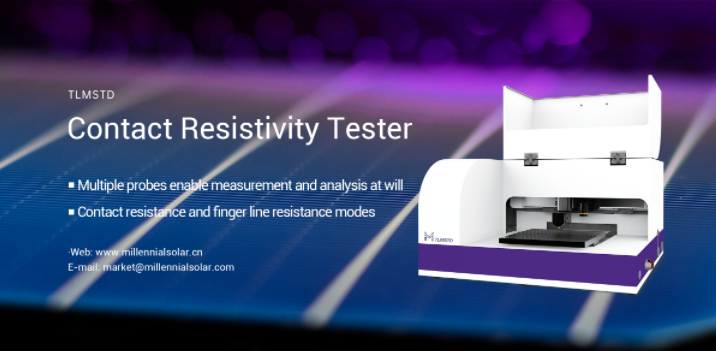
During the contact resistance measurement process, the following factors need to be noted: (1) sample width; (2) edge shunt; (3) current through undetected grid lines; (4) uneven contact resistance; (5) Sheet resistance is not uniform. Next, we will introduce to you the impact of sample width and edge shunt on the results.
Sample width
Samples with different widths have a greater impact on the measured contact resistivity values. The typical relationship between contact resistivity and sample width is shown in the figure below. When the sample width is from 5mm to 25mm, the measured contact resistivity and transfer length also increase accordingly.
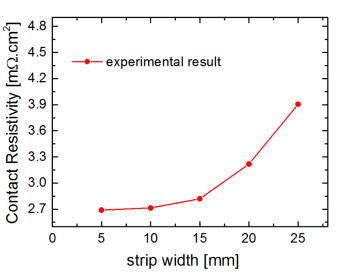
The figure below shows the simulated TLM diagram (i.e. RT vs. contact spacing) for two sample widths (5mm and 30mm) and the ideal state. Ideally, with the same input material properties, if we scale the 5mm results by a factor of 1/6, we should get the same TLM plot. However, as shown in the figure, the contact resistance and transfer length obtained from the 30 mm sample are much greater than those obtained from the 5 mm sample.

edge shunt
It was introduced earlier that different sample widths will affect the contact resistivity. Through multiple measurements of different samples with different sample widths, it was also found that in many results, for small sample widths (5mm), the measured contact resistivity was very large, as shown in the figure below.
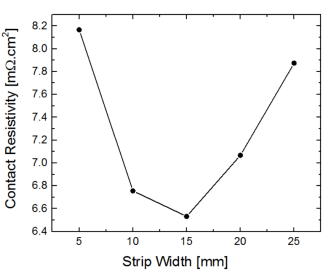
One possibility for this result is that laser cutting induces a shunt effect at the edge of the sample and creates additional shunt paths. The shunt path causes an increase in the measured contact resistance, an effect that becomes more pronounced when the sample width becomes smaller.
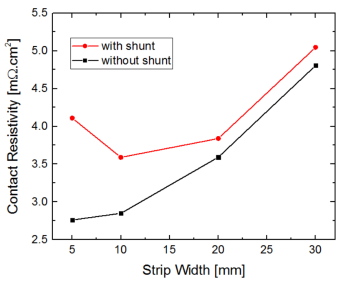
The graph above shows the contact resistance versus sample width for structures with and without edge shunting. We observe that edge shunting results in higher contact resistance measurements at all sample widths, with this effect being more pronounced at smaller widths.
For further analysis, a grid line with a width of 10mm was tested. The results showed that edge shunting changed the voltage distribution of the grid line. The voltage change at the end of the grid line is much larger than normal, indicating that more current is flowing from the end of the grid line.

TLM Contact Resistance Tester
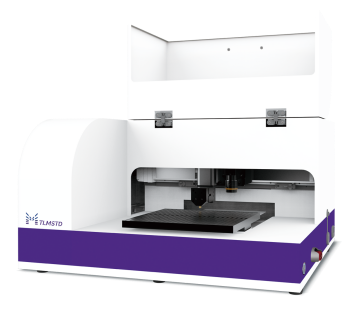
E-mail: market@millennialsolar.com
TLM Contact Resistance Tester can quickly, flexibly and accurately measure the contact resistance and line resistance of solar cells. Reflects problems existing in processes such as diffusion, electrode production, and sintering.
●Contact resistivity test range: 0.1~120mΩ*cm^2
●Line resistance test range: 0.2~40Ω/cm
●Contact resistivity measurement accuracy: 5% or 0.5mΩ*cm^2
●Line resistance measurement accuracy: 5% or 0.1Ω/cm
●Static test repeatability ≤1%, dynamic test repeatability ≤3%
Millennial Solar is committed to researching test conditions, processes and algorithms to improve test accuracy and efficiency to meet different testing needs. TLM Contact Resistance Tester can accurately measure the contact resistance of solar cells to evaluate problems in diffusion, electrode production, sintering and other processes, helping customers accelerate the performance of solar cells!
Want to know more? Please contact us.
For more information about these stories or the Millennial Group, please contact us.
Fast Delivery & Comprehensive Support
Provide customers with comprehensive support from product to production line operation through on-site operation guidance and after-sales technical support.
Name *
Company
Title
E-mail *
Phone number *
City *
Country
Please select a product category
I am interested in receiving information about *
My message